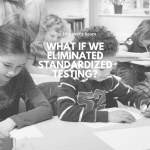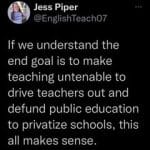Have you signed up for The Educator’s Room Daily Newsletter? Click here and support independent journalism!
Regardless of your opinions on school choice and voucher programs, the conversation around dismantling public education cannot ignore their role. Partly a product of a charter school myself (and later a public school teacher), I take the privatization of K-12 education seriously. Of course, the issues around school choice are complicated and intertwined. Still, the purpose of exploring them here is how they are negatively impacting public education, which ultimately hurts large swaths of students (especially disadvantaged ones).
The first school voucher program was established in the late ’80s in Wisconsin to assist low-income students with disabilities in attending specialized schools financially. Over the next three decades, voucher programs (or “school choice”) have expanded in many states to allow parents to send their children to a “better” school of their choosing. Unfortunately, as the legislation has been altered, this has allowed public money to go to private religious schools and de facto segregated charter schools in many cases.
On the other hand, charter schools were established outside the regulations of public districts, which was meant to allow them to innovate education by avoiding the red tape. Over time they gained traction, especially as it seemed they were showing positive student outcomes. As a result, comparisons between them and public schools became popular despite the most obvious question: How can we compare schools that often do not play by the same rules?
Those rules range from providing free transportation, following specific health protocols (relevant during the pandemic) and enrollment processes. Since charter schools do not offer transportation, many students can be excluded based on their location or parents’ schedule. In addition, the enrollment process may involve school visits, interviews, writing an essay, and other paperwork that can be time-consuming and intimidating for some families. And unfortunately, there is a vast range in quality of charter schools, with many improperly serving their disabled and minority students.
Additionally, charter schools may not have to legally require staff to hold a teaching certificate, depending on the state. On one level, this devalues teaching overall and brings up some other questions about education quality. Over the years, charters have leaned into the privatization of education by hiring floods of Teach For America corps members – people contracted to work as teachers for a couple of years with minimal training before going onto law school or a prestigious career. In states with teacher’s unions, charter school teachers are often unable to join since they work for a private company. This highlights another axillary goal of charters: to dismantle collective bargaining routes for educators.
I bring all this up not to discredit charter schools as a whole but to reveal the inequities that exist and should concern us as they gain traction. I believe without a doubt that we have politicians in power right now that would prefer charter schools and school choice run our education system. In many states, school choice is gaining more popularity in the wake of the pandemic and souring opinions around public schools and unions (examples include Utah, Georgia, Alabama, among others). In my state of Arizona, I have watched as Governor Doug Ducey continually prioritized school choice over public school funding and reform.
The most significant difference between public and charter schools is in the democratic process. Public schools have accountability to their community through regulations that require transparency and school boards. Charter schools by design do not have these things, and many are run by for-profit institutions (remember Betsy DeVos?). That’s right, through vouchers, they can receive public money and still be a for-profit institution with their agenda. This also brings up questions about the politicians who continue efforts to funnel money toward these corporations – we should thoroughly consider what they might stand to gain by doing so.
I fear that we are in the midst of a transition that will leave the disadvantaged students with failing public schools and the privileged students with their pick of quality options. This is already a reality in some places plagued by rampant school choice measures. Public education serves all students: regardless of gender, race, ethnicity, disability, and income. The implications of this reach beyond high school graduation and into access to higher education, gainful employment, and fair wages. Students in our country shouldn’t worry that their parental income or location will disqualify them from a quality education. Who stands to gain from a potentially widening intellectual divide like this?
Please make no mistake; the politicians pulling the strings know exactly what they are doing. Notice that the same politicians who advocate for school reform or increased funding only when tied to school choice tend to be in red states and from a particular political party. Let me call it what it is now: the new school segregation.






